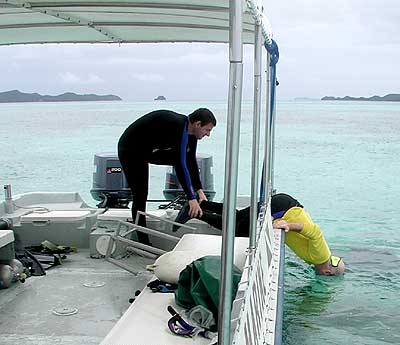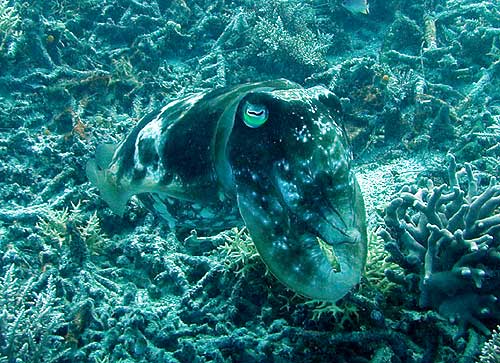| P-MAN VIII Update #17 A water day. We finally had a water day. We've been wanting to get back down to Ngerechong, which sits right on the fringing reef on the east side close to Peleliu, to see if we could extend our understanding of the debris field associated with an Avenger crash there (Scullin). Just inside the reef, there's an Avenger main landing gear assembly just south of the island. It's surrounded by widely scattered small parts. When the wind is out of the east, as it is this time of year, big waves crash onto the reef there, but Joe had said the bottom slopes gradually away from the reef to the east, down to about 80 feet, before dropping off into very deep water. On a day when conditions were right, Joe said, we could explore the area just outside the reef from the landing gear to see if any other parts of the aircraft might have landed just outside the reef but before it drops off to a depth of several thousand feet. Since we have an underwater-capable metal detector on this trip, we thought it might also be good to get out there and ping the shallow area around the landing gear to see if we could turn up anything more of the aircraft inside the reef. One other intriguing twist is that as we were flying back to Koror from Peleliu earlier in the week, we made several low passes over the area and saw what appeared to be part of an Avenger wing, in a previously unexplored part of the shallows just inside the reef. It was definitely a new object, which had probably been buried in sand and was recently uncovered by the long stretch of strong wind from the east. So there were three things on our list: check out the new "wing," use the metal detector in the shallows inside the reef, and do what would probably be a drift dive outside the reef, to see if any aircraft parts might have rolled down the shallow slope out there. We began by investigating the wing. We found it fairly easily, and even from the boat it looked like it had some of the internal structure of an Avenger wing. We were there just after high tide. The depth was only about 6 feet, and the current was running very strongly out toward the reef. We anchored near the object, and struggled against the current to get over to investigate. The object turns out not to be an Avenger wing; it looks more like part of a boat hull.
There's also a fair-sized object near the wing, which we checked out by having Mike dip Dan head-first to take a peek. We're considering checking to see if we can register this as the world's shortest skin dive.
We decided to head outside the reef and see what the area looked like. We wanted to figure out where we'd dive if we did choose to try a dive out there, and needed to judge whether the wind and wave conditions would permit us to dive safely. It looked like wind and waves were going to cooperate, but we wanted to wait until the tide was closer to the low end, with the current not coming so strongly off the reef and out to sea. We headed back inside the reef to the north side of Ngerechong, where there was a nice protected area where we could do a practice dive. Pretty amazing - we've been here two weeks, and this would be our first real dive. We always do at least a short dive under benign conditions just to get our gear and weights adjusted, and to get used to diving with each other. This area turned out to be ideal. Less than 50 feet, pretty coral, not much current, and good visibility. The coolest marine life that we encountered was a couple of cuttlefish, each about the size of a rugby ball. I think they're related to squids and octopi. They're capable of lightning-fast changes in the brightness and color of their skin, and when they're agitated, they can flash like a neon sign. Pat, who generally tries to ignore underwater fauna, actually approached one of these critters and got close enough to touch it.
We ate lunch after the practice dive, and took naps while we waited for the tide to drop. Back outside the reef, we decided on an entry point south of where the Avenger debris lies on the other side of the reef, and planned to drift north with the current while Joe followed with the boat. The bottom here drops gradually from the surface to about 80 feet, where it abruptly drops away out of sight. We decided to spread out with Dan closest to the reef and me closest to the dropoff, and to descend to no more than 60 feet. The visibility was probably over 100 feet, so we'd always be in visual contact with each other. Just as we were about to get started Pat had a problem with his mask, which he had borrowed from the dive shop. It turned out to be broken, so Dan gave his mask to Pat and volunteered to sit this dive out. So it was Pat closest to the reef, me following the dropoff, and Mike in between. The bottom contour in this area is typical just-outside-the-reef topography. There are wide, deep channels and ridges that run perpendicular to the reef, cut over the ages by the huge volume of water that surges up onto the plateau and back off again with each change of the tide. The visibility was great. We were easily able to maintain a fairly constant depth as we cruised along, and if there had been anything there to see, we would have seen it. A large eagle ray and a medium-sized turtle were the only things of interest as we cruised parallel to the reef past the area where the landing gear lies on the inside. If any airplane parts landed on this slope, it's most likely that they'd have rolled down to the break and dropped off into the abyss. At least now we feel comfortable closing out this part of the Scullin site - if there are any parts of the aircraft outside the reef, they're now in water that's far beyond our depth capability to survey. By the end of this dive the tide was reaching its lowest point, so we headed back inside the reef to the area where the landing gear lies and prepared to just hike around and do a survey with the metal detector. The area that had been 5-6-feet deep this morning was now about mid-calf deep. Joe drove the boat as far into the flat, sandy area as he could, but that still left a hiking area several hundred yards square. On a bright, sunny day this area can be brutal - it's all rocky white sand, which reflects the sunlight back up and even burns the underside of your nose. But today there was a high overcast, and it wasn't a bit bad. We all agree that the makers of dive booties, even the hard-soled ones, need to make a version that has ankle support like hiking boots: this kind of walking is really hard on your ankles. Wading in less-than-knee-deep water for hundreds of yards over lots of big rocks ain't easy.
We found some small bits of aluminum out here, but nothing identifiable. The metal detector worked as advertised, but with such a vast area to explore it seems unlikely that we'll ever find any more of this aircraft. We plan to close our investigation of this site, unless we receive reports in the future about finds that fishermen might make in the area. We wrapped up and headed home. We had dinner with Don Haake, shortly before he was to head out for flights to Yap-Guam-Hawaii. He's going to have about a day's layover in Honolulu, and it looks like the folks at JPAC are going to be able to give him the tour of the lab that his mom, Marty, was able to take last June at the repatriation ceremony. - Reid |

- Main Site
- Expeditions
- Our Story
- Miscellany




